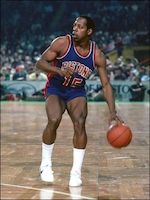Career
What if the Hot Hand Wasn't a Fallacy?
Maybe basketball players really do have hot streaks.
Posted March 22, 2014
I love when this happens. Just in time for March Madness, there is a new challenge to the hot hand fallacy.
A little background. It is a canonical bit of athletic lore that players periodically get “hot.” Basketball players in particular are thought to get into a zone that allows them to drain shot after shot. Standard coaching practice suggests that when a player is clearly hot, the other team members should feed him or her the ball as much as possible to take advantage of this boost in performance.

Vinnie Johnson, "The Microwave."
Then in 1985 Thomas Gilovich, Robert Vallone, and Amos Tversky published an analysis of the Philadelphia 76ers’ 1980-1981 season to determine whether the hot hand was a real thing. At that time, the 76ers were the only team that kept the kind of shot-by-shot data that would make this analysis possible. Gilovich, Vallone, and Tversky concluded that the hot hand was an illusion. None of the players on the 76ers produced streaks of baskets that were substantially different from a random sequence. The belief in the hot hand was simply a misunderstanding of random processes. No one really gets hot at all. You just think you are hot when a completely predictable series of successes comes together in a streak.
Naturally the sports world was not amused. The Gilovich et al. study drew lots of publicity, and I remember seeing interviews with players who took pleasure in denouncing the study with references to “crazy psychologists.” Nonetheless, the hot hand fallacy soon became lore in the scientific community, and the Gilovich, Vallone, and Tversky paper became a seminal publication, subsequently followed by many others. The hot hand fallacy is thought to be closely related to the clustering illusion and the Texas sharpshooter fallacy—both of which involve the tendency to focus on what appear to be meaningful groupings of events in small samples of a larger random process. In the case of the hot hand, it is the tendency to focus on a small streak of hits without adequate reference to the longer sequence of hits and misses. The hot hand fallacy was also applied to gambling (a variation on the well-known gambler’s fallacy) and the behavior of Wall Street traders.
For thirty years the hot hand fallacy has been a standard topic in psychology textbooks. Alan Reifman, a professor of human development and family studies at Texas Tech, writes a popular blog on the hot hand, and he has contributed the only full-length book on the topic, Hot Hand: The Statistics Behind Sports' Greatest Streaks. So for some time—despite the disbelief of many athletes—the hot hand has been settled ground. An established scientific principle.
Until now.
Along come Andrew Bocskocsky, John Ezekowitz, and Carolyn Stein, all 2013 economics graduates from Harvard University, with a serious challenge to the hot hand fallacy. The Harvard group reasoned that, if a hot hand effect actually existed, the player who is feeling hot might attempt more difficult shots. If so, a true hot hand effect would be masked by the lower probability shots chosen. So they attempted to take all of this into account in a new study.
Using an NBA dataset of over 83,000 shots that included optical measurements of the number and location of defenders, as well as game factors, such as the amount of time left on the clock, the Harvard group created a regression model that suggests that there is indeed a small but statistically significant hot hand effect. Player’s who experience the hot hand are 1.2 to 2.4 percent more likely to hit a shot than those not experiencing a streak. Last fall they presented their work at the New England Symposium on Statistics in Sports (video available here), and a write-up of their work is available online. Already the three have gotten considerable attention from the press, including this article in the Wall Street Journal.
This could be a wonderful David and Goliath story of young investigators overturning the established wisdom of their gray-haired elders, but, to be fair, Bocskocsky, Ezekowitz, and Stein’s work has yet to be submitted to peer review. So we will see whether the work stands up to serious scrutiny. But one of the beauties of the scientific enterprise is that it isn’t basketball. We may not always agree, but ultimately we are all on the same team. If the hot hand fallacy is convincingly refuted, I am quite certain its former supporters will welcome the news as an advance in our knowledge. When I contacted Alan Reifman about the study via Twitter he said, “I applaud advancements in methods & analyses.”
So we shall see. Scientists often run up against resistance when they tell a story that conflicts with a more popular one. The reason less than half of Americans believe in evolution is an obvious example. Many people have an alternative story that they find more appealing than the Darwinian one. But this time it may turn out that the scientific story and the story preferred by athletes are almost the same. The effect found by the Harvard group is quite small—smaller than what most athletes believe to be the power of the hot hand—but perhaps this time science and intuition are not so far apart.


